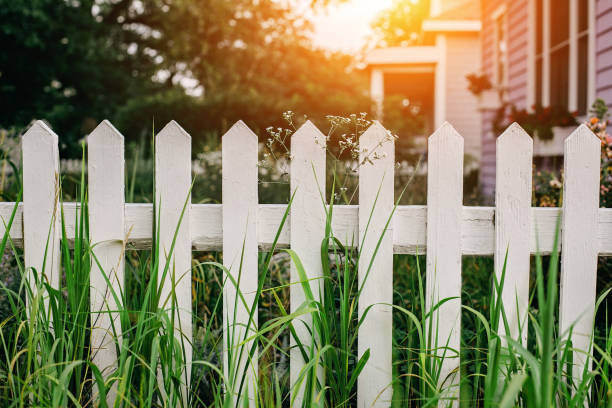
Picket Fences Overview
Picket fences have long been cherished for their classic appeal, offering a perfect blend of beauty and privacy. These fences not only enhance the aesthetic appeal of your property but also provide a sense of security and enclosure. In this section, we will explore the timeless charm of picket fences and discuss their installation and maintenance.
Classic Appeal of Picket Fences
A white picket fence is synonymous with the charm of a traditional American home. It provides a classic and timeless look, giving your property a touch of colonial elegance. The iconic white color adds a crisp and clean feel to the overall aesthetic. Unlike other fences that may obstruct the view of your lawn, a picket fence allows others to see into your yard, enabling you to showcase the beautiful landscape features you have worked hard to create (Albaugh & Sons). This open design not only adds to the curb appeal but also fosters a sense of community and neighborliness.
Installation and Maintenance
Installing a picket fence is relatively straightforward, making it an attractive option for homeowners looking for a quick and hassle-free fencing solution. The installation process is generally quicker compared to other types of fences, allowing you to enjoy the benefits of your fence sooner. This is particularly beneficial if you have other landscape matters to attend to.
Maintenance requirements for picket fences vary depending on the material chosen. Wood picket fences, for example, offer the flexibility to be designed with various styles, colors, and shades, allowing for customization based on personal preferences. While wood picket fences are more affordable compared to many other fencing materials, they do require periodic maintenance such as re-painting, re-coating, and replacing damaged planks to ensure their durability over time (Florida State Fence). On the other hand, vinyl picket fences are gaining popularity due to their easy maintenance requirements. They typically require minimal upkeep, such as hosing down after rough weather, and do not need to be painted (Albaugh & Sons).
Proper installation and regular maintenance are essential for ensuring the longevity and beauty of your picket fence. Whether you choose wood or vinyl, it is crucial to consult with professionals to ensure a high-quality installation. Additionally, incorporating gates into your picket fence design can add both style and functionality, serving as a centerpiece while enhancing the overall aesthetic appeal of the fence.
By understanding the classic appeal and the installation and maintenance considerations of picket fences, you can make an informed decision when selecting a fence that perfectly complements your property, providing both beauty and privacy.
Materials for Picket Fences
When it comes to picket fences, you have a variety of materials to choose from, each with its own unique characteristics and benefits. The two primary options for picket fences are wood and vinyl/metal. Let’s explore each of these materials in more detail.
Wood Picket Fences
Wood picket fences are a popular choice, known for their classic and timeless appeal. They offer a wide range of options, from budget-friendly pressure-treated pine to luxurious redwood. Wood pickets can be stained in any color to match your aesthetic preferences. They also come in various shapes, allowing you to create a customized look for your fence.
One of the advantages of wood picket fences is their affordability. Wood is generally more cost-effective compared to other fencing materials, making it an attractive option for those looking to enhance the visual appeal of their property or keep pets enclosed. According to Florida State Fence, wood picket fences cost around $7-15 per foot, making them an inexpensive choice.
Wood picket fences are also environmentally friendly. Wood is a natural material that requires little manufacturing, can be easily recycled, and is biodegradable. If sustainability is a priority for you, a wood picket fence is a greener option for creating an eco-friendly home.
In terms of durability, wood fences can stand the test of time when installed professionally and properly maintained. Periodic maintenance such as re-painting, re-coating, and replacing damaged planks will help ensure the longevity of your wood picket fence (Florida State Fence).
Vinyl and Metal Options
Vinyl and metal picket fences are another popular choice for homeowners. Vinyl picket fences are gaining popularity due to their easy maintenance. They require little upkeep, such as painting, and can be easily cleaned by hosing them down after rough weather. Opting for high-quality vinyl material is important to ensure better durability against adverse weather conditions.
Metal picket fences are available in options such as steel and aluminum. Steel is known for its durability against various weather conditions and requires minimal maintenance, such as cleaning and painting. Galvanized steel is recommended to prevent rusting when exposed to the elements. Aluminum, on the other hand, is a lightweight alternative to steel and is resistant to bulging (Albaugh & Sons).
When choosing between vinyl and metal picket fences, consider your specific needs and preferences. Vinyl offers low maintenance and a variety of styles and colors to choose from. Meanwhile, metal picket fences provide durability and strength, making them an excellent choice for those seeking long-lasting fencing solutions.
Whether you opt for the classic charm of wood or the low-maintenance benefits of vinyl or metal, a picket fence can add beauty, privacy, and security to your property. Choose the material that best suits your needs and budget, and enjoy the allure of a well-crafted picket fence for years to come.
